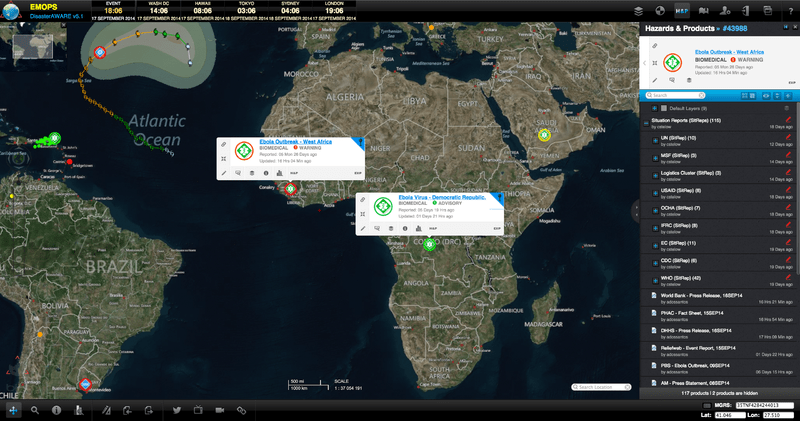The Ebola Virus Disease (EVD) epidemic now affects countries in and around West Africa (Guinea, Liberia, and Sierra Leone, Nigeria, and Senegal), while a second unrelated strain of the virus has appeared in the Democratic Republic of Congo. Additionally, the U.S. CDC confirmed a case today in Texas, United States, resulting from a patient who had contracted the disease while traveling in West Africa. To address the unprecedented transmission rates of the virus, resources are being mobilized to combat the pressing preventative and curative health needs, as well as the evolving social, economic, and security implications.
Pacific Disaster Center (PDC) is actively supporting interagency information sharing for the Ebola crisis through its DisasterAWARE decision support platform. Secure access is offered for disaster management professionals through the Emergency Operations (EMOPS) system, while hazard alerts and related information are available to the public through the Global Hazards Atlas or the Disaster Alert mobile app.
A quick snapshot of ongoing Bio/Med hazard information includes:
- The humanitarian community is facing serious logistical challenges. World Food Program (WFP) is leading the Logistics Cluster, providing logistical support, information management, and coordination services for activities and pulling data together to assess the widespread impacts of Ebola.
- World Health Organization (WHO) is leading the Health Cluster and heading up coordination out of the Sub-Regional Ebola Operations and Coordination Centre (SEOCC).
- Medecins Sans Frontieres (MSF), known in the U.S. as Doctors without Borders, is heavily engaged in on-the-ground response. They are hosting a webpage on Ebola.
- USAID provides regular factsheets on the Ebola outbreak and—along with the Office of U.S. Foreign Disaster Assistance (OFDA), Centers for Disease Control and Prevention (CDC), Department of Defense (DoD), and the U.S. Forest Service—have had Disaster Assistance Response Teams (DART) deployed to the region to coordinate and prioritize U.S. government response.
- CDC is assisting with airport screening and offers information about Ebola as well as recommendations for travelers.
- A number of additional non-governmental organizations (NGOs) are responding to the crisis in West Africa. USAID Center for International Disaster Information is hosting a webpage listing involved NGOs. Interaction.org has put together a list of member organizations that are part of the relief effort.
Updates to these and related news items and information resources are being posted to DisasterAWARE. If you are an emergency manager and would like access to DisasterAWARE through the Emergency Operations (EMOPS) system, email PDC at info@pdc.org.
For more information about Ebola and its impact visit:
• Center for Disease Control and Prevention (CDC)
• Food and Agriculture Organization of the United Nations (FAO)
• International Federation of Red Cross and Red Crescent Societies (IFRC)
• Medecins Sans Frontieres (MSF)
• World Health Organization (WHO)
• Reliefweb
• USAID and the Center for International Disaster Information (CIDI)
• United Nations Children’s Fund (UNICEF)
Learn how to use DisasterAWARE with this DIY series:
• Learn about Map Tips,
• Learn about Layer Navigation,
• Learn about Layer Controls, or
• Learn about Area Brief.
